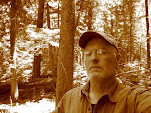I pass a large beaver lodge, scare up a few hooded mergansers and a few more wood ducks. A hawk settles into a tree on the left bank and leaves just as I get near enough to start identifying it. A long broken chevron of honking Canada geese flies overhead and a second hawk winds its way through the trees on the right bank. Here, the river is a boulevard, bordered by a thin line of trees on each bank with wide open expanses of marsh beyond. The water is high with snow melt and recent rain.
I catch the Mattabesset at a rare moment. It is coming out of winter slumber, it is the cusp between winter and spring, it is a temporal edge, and edges are where the life is. In its starkness with remnants of snow and the cattails and wild rice crushed flat, the life is a strong contrast. Already, several hawks have flown by. I note the recent workings of a beaver and soon come across a rather small lodge. There is no sign of winter food storage; branches and saplings stuck into the river bottom near the lodge where they could be accessed under the ice. Perhaps that isn't usually necessary on the Mattebasset or maybe they ate all that was stored. There are several trees with bare wounds from gnawing and they do not look like felling was ever intended as the gnawing ends with the nutritious inner bark. It looks like they were forced out onto the snow and ice to find food during our unusually harsh winter.
As the boulevard gives way to the open marsh, I spot a mature bald eagle, and farther down, four immature bald eagles, more hawks, and a great blue heron. Just before entering the forest near the big river, a startled muskrat skips like a stone across a mat of downed cattails before completing its submerged evasion.
I return the way I came, but never return the way I was.
Bodies of water
20 hours ago







































